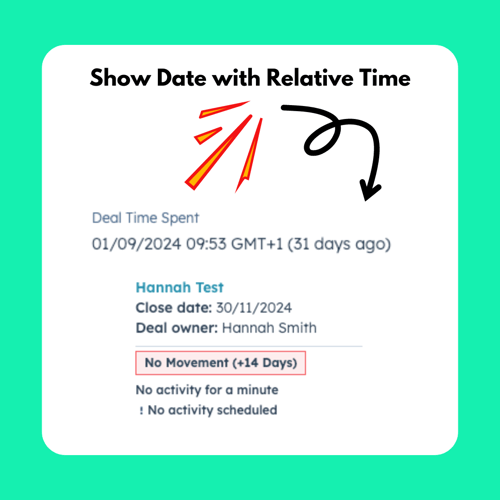In today’s fast-paced business world, sales teams are under constant pressure to close deals faster and more efficiently. Yet, one of the most common challenges is understanding exactly how long deals linger in each stage of the pipeline. Without visibility into this critical metric, sales cycles can drag on, leading to missed opportunities and underwhelming results.
To help you tackle this challenge, we’ve developed a process framework to track and manage Deal Time Spent within HubSpot. Let’s walk through the steps for setting up a streamlined process to monitor deal progression and uncover opportunities for improvement.
The Process Framework: A Step-by-Step Guide
Step 1: Enable Relative Time in the Date Picker
Start by creating a property in HubSpot that allows you to track Deal Time Spent.
Here’s how:
- Navigate to Settings > Properties in HubSpot.
- Create a new deal date picker property called ‘Deal Time Spent.’
- Under “How should this property appear in records?”, select “Show Date with Relative Time” to ensure the time spent is easy to interpret.
This gives you the foundation to begin tracking how long each deal remains in its current phase. Please note that the relative time option is currently in BETA. If you haven't already, you'll need to request access to it.
Step 2: Create a Deal Workflow
Next, automate the process of tracking Deal Time Spent using HubSpot workflows:
- Set the trigger to “Deal stage is known” (allowing re-enrollment).
- Add a step that date-stamps the ‘Deal Time Spent’ property with the current date each time a deal enters a new stage.
- Be sure to exclude all existing deals upon workflow activation - this ensures accurate data collection going forward.
By automating this, you eliminate manual tracking and ensure that every deal is consistently monitored.
Step 3: Export Deal Data
To ensure you have all the relevant historical data, export all your deal date properties:
Export ‘date entered’ properties along with Record IDs for key stages such as "Date entered Discovery," "Date entered Appointment Scheduled," and "Date entered Considerations." This data is crucial for mapping past deal stages and calculating accurate time spent.
Please note, you can skip this step as well as steps 4 and 5 if you're starting fresh in HubSpot and don't have any deals in a pipeline yet. These steps are only necessary for handling pre-existing deals.
Step 4: Create a Formula in GSheet/Excel
In this step, you’ll analyse the exported data and calculate the most recent dates for each deal stage. Build a formula that:
- Returns a single date if only one exists.
- Returns a duplicate if the latest date appears more than once.
- Returns the most recent date if it is unique.
This step helps you identify the latest deal date without the need to manually review each deal record. Once the formula provides the latest date, you can use it to update the "deal time spent" property during the import, laying the groundwork for accurate tracking.
Step 5: Import Updated Data into HubSpot
Now that you’ve got the calculated data, it’s time to bring it back into HubSpot:
- Map the most recent stage date to the "Deal Time Spent" property via a HubSpot import, ensuring you use the Deal Record IDs as the unique identifier.
- Manually update the most recent dates for deals that entered the workflow prior to the import (this accounts for any deal activity that occurred while preparing the import file).
Once this is done, your HubSpot system will be fully equipped to track deal progression across all stages.
Step 6: Monitor Deal Time Spent
Finally, use this data to actively manage deals:
- Set up a deal tag to highlight deals where ‘Deal Time Spent’ exceeds 14 days in any given stage. This ensures timely follow-ups and keeps deals from stagnating.
With this simple alert system in place, your sales team will always be aware of deals that need immediate attention, driving faster movement through the pipeline.

Key Performance Indicators (KPIs): Measuring Success
Once your Deal Time Spent tracking is up and running, it’s important to regularly measure the impact on your sales performance. Here are a few KPIs to consider:
Pipeline Efficiency: Track the percentage of deals that exceed your target threshold (e.g., 14 days in any stage) and aim for a consistent reduction over time.
Revenue Impact: Assess whether quicker deal progression translates into measurable revenue growth. Faster deal cycles should ultimately lead to more closed deals and a healthier bottom line.
Average Deal Time per Stage: Measure the reduction in the average time deals spend in each pipeline stage. This will help you pinpoint specific stages that require additional focus or resources.
Conclusion: Putting Time Back on Your Side
By implementing a robust Deal Time Spent tracking process, you’ll gain invaluable insights into how your sales pipeline is functioning. With better visibility into where deals are stalling and for how long, your team can act swiftly, target their efforts more effectively, and ultimately close deals faster.
At the end of the day, it’s about giving your team the tools they need to make smarter, data-driven decisions - keeping your pipeline efficient, your deals moving, and your revenue growing.
Ready to transform your sales process and accelerate deal progression?
Book a consultation with us today, and let’s work together to streamline your pipeline and drive better results.

